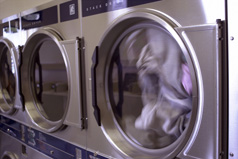Over the last several weeks, MCFRS has responded to a number of clothes dryer related fires. A lack of maintenance, buildup of lint, placing inappropriate items in the dryer and inadequate venting are frequently cited as contributing factors. Please take a moment to review some very important tips below.
Did You Know?
- The U.S. Consumer Product Safety Commission (CPSC) estimates that 15,500 clothes dryer fires occur annually, causing an average of 10 deaths, 310 injuries and more than $84.4 million in property damage.
- Eighty-percent of American homes have clothes dryers.
- A full load of wet clothes placed in a dryer contains about one half gallon of water. As the clothes dry, lint forms and builds up, reducing airflow in the dryer's vent, potentially causing the dryer to work improperly or overheat.
Clothes Dryer DOs:
- DO clean the lint screen/filter before or after drying EACH load of clothes.
- DO clean the dryer vent and exhaust duct periodically.
- DO have a certified service technician clean and inspect the dryer and venting system regularly.
- DO replace plastic or vinyl exhaust hoses with rigid or flexible metal venting, which provides maximum airflow.
- DO keep the area around the dryer clean and free from clutter.
- Always use the appropriate electrical outlet for dryers and all major appliances.
Clothes Dryer DON'Ts:
- DON'T place clothing or fabric stained with a flammable substance, such as alcohol, cooking oils, gasoline, spot removers or motor oil, in the dryer. Flammable substances give off vapors that could ignite or explode. Instead, dry the materials outdoors.
- DON'T leave a dryer operating if you are not home.
- DON'T forget to read the manufacturer warnings in the user manual and on the inside of the dryer door DON'T dry any item containing foam, rubber or plastic, such as bathroom and non-slip rugs and athletic shoes.
- DON'T dry any item that contains glass fiber materials, such as a blouse or sweater with glass buttons or decorations.
- DON'T overload the dryer with wet clothes.


3 comments:
Thank you so very much for keeping the public informed. I forward your emails to some members of my family. Thank you for all you do.
In regard to "DO clean the dryer vent and exhaust duct periodically," clean the flap that closes the exhaust that is located OUTSIDE when the flap is stuck open.
Sparrows built a nest inside my exhaust tube, which restricted exhaust, keeping clothes so damp that the clothes needed a second cycle.
So make a habit of looking at the flap when you're in the yard. Clean it so it closes properly as soon as you see it stays open when the dryer isn't running. "An ounce of prevention is worth a pound of cure."
Good advice!
Post a Comment